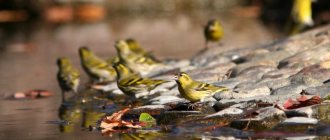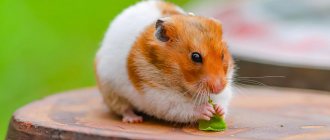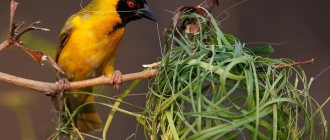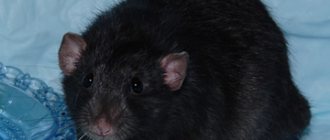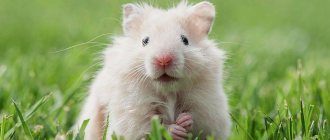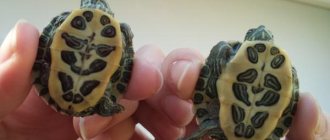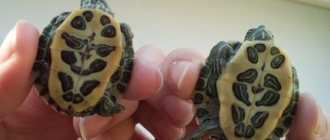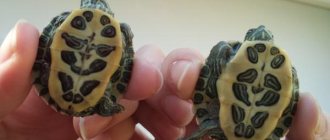Description of the stork
Storks range in height from 60 to 150 cm. All or part of the head and the upper part of the neck may not have feathers and are usually brightly colored. The stork bird is silent or almost silent due to the lack of a fully developed syrinx (the vocal organ of birds), but some of them rattle their beaks loudly when excited.
They fly, alternately flapping and gliding, with their necks outstretched and their legs stretching. Storks are found mainly in Africa, Asia and Europe. One species of stork, the black stork, is also found in Australia.
Most storks gather in flocks, except during the breeding season, when they mate.
What do storks eat? The stork continues feeding all day. Most of these birds eat small animals caught in shallow waters and fields. Some storks, like the marabou stork in Africa or, as it is called in India, the adjutant bird, feed mainly on carrion.
White storks
A stork's nest is a large branched platform, built by both a male and a female stork, in trees or on rocky ledges. The white stork builds its nest on roofs and chimneys.
Typically, a stork hatches from three to six eggs. The eggs are hatched alternately by both parents. Usually stork eggs are snow-white. Stork chicks hatch approximately five weeks from the start of laying.
Lifestyle and habitat
These birds choose meadow lowlands and marshy areas to live. Storks usually do not form large flocks, preferring solitude or living in small groups. The exception is the wintering period, then the societies in which such birds gather can number up to several thousand individuals.
An interesting fact is that during long flights, storks are even able to sleep in the air. At the same time, the breathing and pulse of these living beings becomes less frequent. But in this state their hearing only becomes more sensitive, which is necessary for birds in order not to get lost and not to get separated from the flock of their relatives.
For this type of rest in flight, a quarter of an hour is enough for birds, after which they wake up and their bodies return to normal.
During long flights, storks are able to fall asleep in flight without losing their “course”
When communicating with each other, storks are not characterized by sentimentality, because these graceful, beautiful-looking birds beat their sick and weakened relatives to death without any pity. Although from a practical point of view, such behavior is very reasonable and contributes to healthy natural selection.
It is interesting that in the works of writers of antiquity and the Middle Ages, the stork was often presented as the personification of caring for parents. There are widespread legends that such birds touchingly care for elderly individuals when they lose the ability to care for themselves.
Types of storks
Storks are divided into typical storks (subfamily Ciconiinae) and wood storks (Mycteriinae).
Wood storks (one species of Mycteria and three species of Ibis), originally called ibises, had curved bills, reminiscent of ibises in this respect. Typical storks have a straight or almost straight beak.
The wood stork (Mycteria), adjutant stork (Leptoptilos dubius), or adjutant bird is found in India and Southeast Asia, and the lesser adjutants (L. javanicus) are typical scavengers with bare pink skin on the head and neck.
The African wood stork (Ibis ibis), or yellow stork, is about 100 cm tall, has a yellowish beak and a red scalp.
The black stork (Ciconia nigra) is found in Europe, Asia and Africa, is about 100 cm tall, black with a white belly patch, red beak and red legs.
Two open-billed storks are called barnacle storks , found in tropical Africa and southern Asia. These are small storks that feed on snails.
The saddle-billed stork or saddle-billed stork (Ephippiorhynchus senegalensis) is a beautiful, graceful stork of tropical Africa. The height of this stork is more than 120 cm. The saddle-backed stork has exceptionally long and thin legs and neck. The slightly curved red beak resembles a saddle - hence the name of the stork. The beak is crossed by a wide black stripe, crowned in front of the eyes with a small yellow plate.
Saddle-billed stork
The white stork (Ciconia ciconia) is found throughout Europe and Asia and winters in South Africa. It is a majestic bird, about 100 cm tall, white with black feathers, a dark red beak and reddish legs. Its numbers are declining, partly due to human destruction of its habitat. Only one species, the eastern white stork (C. ciconia boyciana), is considered critically endangered. The Red Book really contains such a sad page as the “white stork”.
Photo of a white stork flying
The wood stork (Mycteria americana), often erroneously called the "jabiru", ranges from the southern United States to Argentina. It is white with black wings and tail and a curved dome.
Lifestyle
Storks always settle in damp places closer to water bodies. They live in pairs or families, fly well and are not afraid of long journeys. The structure of their body allows them to masterfully use the movement of air masses to save energy in flight.
Stork habitats
The habitat of the stork depends entirely on what specific species we are talking about. In Europe you will meet white and black storks. Moreover, they have completely different preferences. Some species have nothing against being in the vicinity of humans, but in this case they choose inaccessible high places.
Photo: kipmu.ru
Diet
Storks hunt on land, slowly walking around the area and quickly grabbing prey. They eat frogs, toads, fish, small rodents, lizards and just about anything they pass by. Some species, like marabou, can even feed on carrion.
Photo: goodfon.ru
Wintering
In Europe and Russia, storks fly away to spend the winter in the warmth. Young individuals fly away earlier, following instinct. And adult birds begin their journey only in September. In flight, storks cover enormous distances, up to 200 km per day. In Russia they return quite early, by the end of March.
Photo: pxhere.com
Finch (50 photos): description of the bird, habitat and what it eats
Stork family
The family of storks (Ciconiidae), distributed among 20 species throughout the globe except North America, is characterized by a hard, straight beak, the upper jaw of which does not have a longitudinal groove, but is sometimes equipped with a short groove in front of the opening of the nostril. The cover of the lower leg, consisting of hexagonal scutes, connecting membranes between the three front fingers and, finally, a straight-cut or slightly rounded tail, which is fork-shaped only in exceptional cases.
Storks live in flat, richly irrigated and forested areas. They do not have a real voice, but they make a cracking sound by striking their jaws against each other. They rest and nest on trees and roofs of buildings. They usually form large communities only during flights; they also nest in colonies only as an exception. Stork nests are quite strong buildings, which birds often use for many years in a row, in which case the nest often acquires very significant dimensions.
Saddle-billed stork beak
Storks fly relatively calmly, with their necks stretched forward and their legs pointing backwards; they do not flap their wings very quickly and soar from time to time. In the so far known species of the genus stork (Ciconia), the beak is straight and slightly compressed laterally, the head is usually bare only the edges of the eyes and a fork-shaped place on the chin, the tail is chopped off, its upper coverts are sometimes strongly developed, shaped like rudders, and the coverts located along the edges of the tail, reach its end and form a fork.
Along the banks of rivers in low-lying areas, near lakes and ponds, in swamps and bogs, in lowlands covered with meadows and cut by ditches, on cultivated land the white stork (C. alba) lives, however, it is never found in grains, reeds and reeds .
stork nest
Where there are few buildings, this stork builds, often in the company of its own kind, nests on tall trees with widely spread branches or with a broken top; in general, it likes to nest on the roofs of churches and houses, on chimneys that are not in use, or on people’s huts , who often put out cart wheels or large flat baskets specifically for him.
The nest is built from sticks, brushwood, twigs, lumps of earth, pieces of turf, reeds and reeds, straw, rags and similar material and reaches 1-1.5 meters in diameter. Usually a pair of storks uses the same nest every year, often taking possession of it only after heated fights with another pair, adjusting it again every year and thus often increasing the height to one meter or more.
Photo of a white stork in the nest
In such a high building, sparrows and city swallows sometimes find shelter and a place for a nest, and less often, starlings and house redstarts. When the weather is favorable, the stork often appears at the nest at the end of February, but usually only in March, sometimes unexpectedly.
Security status
Wetlands around the world have been drained for agricultural development, and the habitat of the Far Eastern white stork is no exception, especially in breeding areas. In Russia, nesting sites are at risk due to spring fires, which destroy tall trees suitable for nesting, causing delayed reproduction and reduced reproductive success. In the black-billed stork's wintering grounds in China, overfishing is reducing food availability. Throughout its entire range, despite legal protection, this species of stork suffers from hunting and capture for zoos.
The Far Eastern stork is protected by law in Russia, Mongolia, China, North Korea, South Korea and Japan. It also benefits from many protected natural areas in Russia and China. The reintroduction of programs to protect black-billed storks in South Korea and Japan should help reduce population declines, but more protected areas are needed in the future to prevent habitat loss, a major cause of the bird's decline. Maintaining tall trees and adding artificial nests in potential breeding areas, as well as controlling human disturbance during nesting, will also encourage the birds to recover. Further protection efforts include campaigns against the use of fire by farmers and poaching of the nesting grounds of Far Eastern white storks.
Stork is a migratory bird
Many people ask: is the stork a migratory bird or not ? The stork is definitely a migratory bird, especially the well-known white stork . Of course, African storks do not fly - they are already warm. Our storks fly to us in small flocks, which then break up. The first to the nest is usually the male, and after a few days in the morning you notice the female, who has flown in at night. If a sudden frost sets in, the couple still remains in place, since the storks in these cases do not migrate south again, but try to find food for themselves on the ice-covered waters. Storks often have to endure poverty and even die of hunger. That's why storks fly away for the winter .
Storks fly south for the winter from the end of July. Beforehand, they wander around the vicinity of the nest, little by little they gather in flocks in vast meadows, and at the end of August they disappear completely. Migratory flocks consist of 5–5000 individuals.
Reproduction and raising of offspring
After the male finishes building the nest, he begins searching for a partner. In pairs, males are chosen by females, looking at those applicants who have already managed to acquire housing. The female who is the first to fly up to the finished nest becomes its named spouse.
Sometimes females can start a fight over a male, while the males themselves wait for the fight to end.
The created pair never breaks up, and the birds live with each other until old age. The exception is when one of the couple dies and the spouse is forced to select a new partner.
White stork
Hatching chicks
In mid- or late April, the female white stork carries 3 to 5 pure white or yellowish-white eggs into the nest, which she incubates alone. The male provides her only with food. When the chicks hatch from the eggs, which the female continues to warm for one day, the nest is never left by both parents at the same time.
A whole month passes before the chicks learn to stand, and they remain in the nest for more than two months. In the first days, parents shove digested food down the chicks' throats, so that all they can do is swallow it.
Eggs in the nest
Subsequently, the parents first place food in the nest, and then on the edge of it, that has only been in the throat. At first, white storks feed their chicks with earthworms, leeches, insects and their larvae, later they get frogs, snakes, fish, birds and animals. Among mammals, the white stork catches, in addition to a large number of mice, moles and even young hares. He also eats poisonous snakes, after breaking their heads with his beak and breaking their spine.
Stork hatches chicks
The stork probably kills the toad, but never eats it. The chicks lie on their bellies for about ten days and only after this time do they begin to rest on their heels. Only little by little do they learn to rise to their feet. The behavior of the chicks becomes very amusing when they learn to jump in the nest, flap their wings and crack their beaks.
Listen to the sound of the stork:
The stork carries itself with dignity, walks majestically and flies beautifully, stretching out its neck and legs. When taking off, it jumps several times, then makes several moderate beats in the air with its wings, even flaps them abruptly, and finally glides through the air without visible movements of its wings.
Flight of storks
Storks fly relatively calmly, with their necks stretched forward and their legs pointing behind them, they do not flap their wings very quickly and soar from time to time. In the so far known species of the genus stork (Ciconia), the beak is straight and slightly compressed laterally, the head is usually bare only the edges of the eyes and a fork-shaped place on the chin, the tail is chopped off, its upper coverts are sometimes strongly developed, shaped like rudders, and the coverts located along the edges of the tail, reach its end and form a fork.
In the spring, the spouses of one couple, flying against each other in wide spirals, often rise in the air to an immeasurable height. The stork does not make real vocal sounds even during the mating period; old storks hiss somewhat, and young ones emit a hissing squeak. But the stork can loudly crack its beak, and at the same time, at least while standing, it throws its head on its back so that the lower jaw is upward, and in this strange position strikes its jaws against each other.
Stork flight
The young ones become accustomed to cracking their beaks already in the nest. This crackling sound is stronger in the male than in the female, and expresses joy, demand, hunger, anger and rage. With a crash, storks rise into the air, setting off on their journey in the fall, and they greet the nest with a crash when they appear at it in the spring.
The stork defecates no less strangely - it squirts feces in front, between its legs. The stork hides its beak just as strangely when it rests, standing on one leg. He does not stick it into the feathers of his back, as other birds do, but warms it, especially willingly in cold weather, between the long feathers of his neck.
In Turkey the stork is revered for its ability to destroy locusts, but in Greece it is hated and persecuted like the Turkish bird. In Russia, where the stork is still common in some places, its distribution area, reaching 57° north latitude, is spreading increasingly to the east. The stork winters in most of Africa. The length of the bird reaches almost 89 centimeters. Its color is generally white, but the flight feathers, large wing coverts and shoulder feathers are black, the throat, beak and legs are red.
Black stork
The only Central European relative of the white stork, the black stork (C. nigra), loves the same places where it settles. The distribution of this species is almost as extensive as that of its white relative - to the north it extends, however, barely to the latitude of Sweden.
Black storks
Black stork nests:
- in Central and Southern Europe
- throughout Central Asia to China in the east.
He winters in:
- India,
- Persia,
- Palestine,
- Central, Western and Southern Africa.
Among the European countries on migration, it is found in Holland, France, Spain, Italy and Greece. In the spring, it happened here more than once to observe migrating flocks of several hundred pieces. The black stork nests less frequently in Germany - it is one of the greatest rarities. Nevertheless, it appears annually on the Rhine and sometimes on the Main. In Hungary, the black stork nests especially often in the middle Danube basin.
There is a whole colony of black storks in southern Hungary. However, there can be no talk of a real nesting colony, such as we are accustomed to seeing, for example, among herons. The black stork is found everywhere less frequently than the white one and, in contrast to the latter, avoids human habitation.
Photo of a black stork
It settles on plains, areas abounding in forests, adjacent to large rivers, lakes and small reservoirs. The black stork can also be found in real mountain forests, if they have suitable bodies of water for it.
Black stork caught a fish
The black stork's nest is located on the thickest and tallest trees of the forest area it occupies, but not at the very top, but most often on a thick branch extending from the middle or from the border of the second and third third of the tree - often it is far removed from the trunk. At the end of April, the nest contains from 2 to 5, usually 4 eggs of a light bluish-white color.
Black stork nest
The black stork does not differ in lifestyle and food from the white one. Its orange-yellow fat has an extremely unpleasant odor, but is not poisonous, as has been stated more than once. Biologically, it is somewhat reminiscent of herons in that it feeds primarily on fish. The length of the black stork is 86.5 centimeters, the color is brown-black with a metallic tint, only the chest, belly and thighs are white - the beak, throat, eye circles are red in old birds, greenish in young birds. The black stork is listed in the Red Book.
Population and species status
In Western Europe, the number of these birds has been declining for many years, and there are no longer black storks in Scandinavia. At their wintering grounds in India, the number of these birds is also constantly decreasing. Previously, this bird could be seen within the Mai Po swamp, and in large numbers. Nowadays, it is unlikely that a black stork will be found within this swamp. A similar picture is observed throughout the Chinese habitat.
The habitat of black storks has recently undergone significant changes in much of Eastern Europe, as well as in Asia, which poses a serious threat to these birds. On the territory of Russia, natural habitats are also being reduced as a result of deforestation in particularly large volumes. As a rule, large trees on which black storks build nests are destroyed first.
In Asia and southern Europe, storks are threatened by hunters, which can lead to the destruction of breeding populations. In northern Italy there is a valley of the Ticino River, within which black storks previously lived. So, nowadays there are no black storks here! In 2005, scientists released several individuals into the Lombardo del Ticino park to try to restore the lost population.
Current populations of black storks are threatened by:
- Active development of new territories.
- Construction of dams.
- Construction of irrigation structures, as well as construction of hydroelectric power stations.
On the territory of the African continent, the same development of new territories is practiced with the aim of allocating them for agricultural needs. This factor, in turn, involves the use of various chemistry, which kills various representatives of living nature. In addition, birds die from collisions with power lines and overhead cables.
Indian downy stork
A relative of our storks is the Indian downy stork (Ciconia episcopus), which lives in addition to East India also in Western India and on the Indian islands. It is much smaller in size than our white stork, and is dressed in black plumage with a coppery sheen. Its tail and rump, however, are white, and its neck is covered with short and soft white feathers, similar to down.
Indian downy stork
It differs from the African downy stork mainly in that the entire upper part of its head is black.
Nutrition and feeding behavior
The food spectrum of white storks is very diverse and variable due to the location of this population. Their main food is small vertebrates and various invertebrate animals. The favorite food of European storks are frogs, toads, snakes (including poisonous vipers), as well as large grasshoppers and locusts. However, white storks willingly eat earthworms, various beetles, small fish (including dead ones), lizards, small rodents, chicks and bird eggs. Thus, the “peace-loving kind” stork is a real predator. Living in villages, storks deftly catch chicks and ducklings that have become separated from their mothers. During wintering, storks often feed on locusts. Looking for food, storks slowly walk on land or water, and when they see prey, they quickly and deftly grab it.
Gigantic stork
The genus gigantic stork (Mycteria) contains not only the largest storks, but in general the largest representatives of the group of wading birds. It is characterized by a beak strongly flattened laterally, gradually curved upward at the tip, and sometimes flat on the forehead. One species of this genus lives in the tropical countries of Asia, Australia, Africa and America.
The Indian representative, the Indian giant stork (M. asiatica), is distributed from Eastern India, on the one hand, across Western India and Ceylon, and on the other, across the Indian Islands to Australia. It lives, usually alone or in pairs, along the banks of large rivers and ponds and in swamps, where it feeds on reptiles, frogs, fish and mollusks.
Great-billed stork
Peculiar storks include the genus of large-throated storks (Leptoptilus), widespread throughout the tropical countries of Asia and America. Its representatives are characterized by a straight conical beak and are distinguished from other storks by a free-hanging crop sac, a naked head and upper neck covered with sparse down, soft and curly lower tail coverts and their stocky appearance.
Great-billed stork
In its way of life, it resembles kites, with which it attacks carrion and, in human-inhabited areas, plays the role of flayers.
Argala
The more famous of the two representatives of this genus, the argal (L. dubius), ranging from Northern Hindustan through Eastern India to Sumatra, Java and Borneo and often found in the vicinity of large cities, appears, for example, in large flocks in Calcutta in the hot season. Previously, when the cleanliness of the city still left much to be desired, the argala at night usually sat on the roof of the governor’s house and other tall buildings in the city.
Argala stork
As a useful cleaner of street sewage, he enjoys the protection of the law in many areas, but, in addition to carrion and other garbage, he also eats reptiles, frogs and fish. This bird is also called the bald stork orderly . This bird hatches its eggs in large societies, often together with pelicans, and it is remarkable that although it has no vocal muscles and usually cracks its beak like our storks, it can nevertheless produce a cry reminiscent of the lowing of a cow.
Natural enemies
Due to the large size and high location of the nests, storks do not have many enemies. Most often, their numbers are declining due to climate change, landscape changes and human activity. A dangerous enemy in modern cities is power lines. In addition, it has been precisely proven that sometimes storks themselves clear their population of weak individuals.
Photo: proprikol.ru
Starling (50 photos): description of the bird, habitat and what it eats
Opening Stork
The fourth genus of stork birds present in India is the raspberry (Anastomus), one of its two species belonging to Africa and the other to India. The razin differs from other genera of stork birds in the shape of its beak, the halves of which do not meet each other at the end, but are equipped with leaves along the cutting edge. In addition to fish, frogs, insects and worms, these birds also feed on shells, deftly opening them and eating the contents; in this case, perhaps, they are helped by the peculiar structure of the jaws.
Stork gaping
The Indian representative of this genus, the Indian open stork (A. oscitans), lives in Western India.
What does a stork eat in the wild?
Storks are predators by nature. They hunt reptiles and fish. The bird's diet consists of frogs, crabs, and eels. During the mating season, it is supplemented by small mammals. Storks feed their chicks with mollusks, beetles and worms.
Storks can eat snakes. They do not even shy away from poisonous species like vipers. Birds are able to sneak up on prey unnoticed and pick it up with a strong beak. After this, the storks try to stun the snake, and then swallow it whole.
The diet of white storks includes lizards, grasshoppers, and small vertebrates. When hunting, birds are quite leisurely and can wait for their prey for a long time. However, when the decisive moment comes to grab prey, the birds show great speed and agility.
Tantalum
The fifth and last genus of stork birds represented in India is Tantalus, 4 species of which are distributed in the tropical countries of Asia, Africa and America. It differs from other storks in the shape of its beak, which is rounded at the tip and rounded at the top and slightly curved downward, thus occupying the middle between the beak of the ibis and other storks.
stork tantalum
The Indian representative of this genus, the Indian tantalum (T. leuco-cephalus), known as the pelican ibis, belongs to the most famous birds of India, common in areas rich in water. It lives alone or in pairs, often nests socially in large trees near villages, easily becomes tame and is then very trusting of humans.
